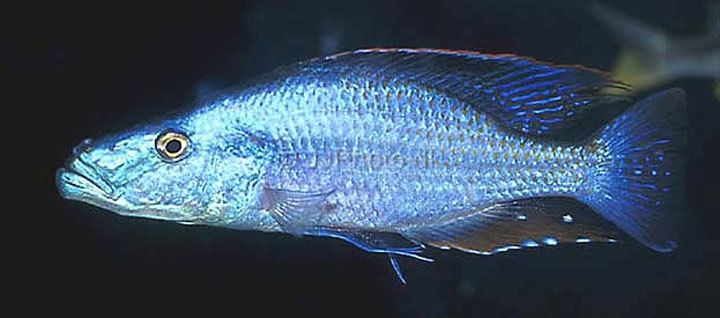Order Perciformes Rank Species | Phylum Chordata Higher classification Dimidiochromis | |
 | ||
Scientific name Dimidiochromis compressiceps Similar Dimidiochromis, Cichlid, Nimbochromis venustus, Nimbochromis, Nimbochromis livingstonii | ||
Malawi eyebiter (Dimidiochromis compressiceps) is a species of fish in the family Cichlidae. This predatory cichlid is endemic to Lake Malawi in East Africa.
Contents

Description

Dimidiochromis compressiceps can reach a length of about 23 centimetres (9.1 in). The females are considerably smaller than males. The body is narrow and laterally compressed (hence the Latin name compressiceps) minimizing its visibility. The mouth is quite large and jaws are relatively long, reaching about one-third of the body length. This large and impressive cichlid normally shows a whitish-silver body with a brown horizontal stripe along the sides, from the snout to the tail. Sexually mature males put on a dazzling metallic blue with reds and oranges on their fins.
Behavior

This species once was regarded as a specialist, feeding on eyes of other fishes (hence the common name eyebiter), (Winkler, 1966) but such behavior has never been observed in the wild.

Though the eyeballs of cyprinids have been found in gut samples taken from this species, it is not clear whether this is normal feeding behaviour or occurs only when food is scarce, as with the North American cutlips minnow, which also displays this feeding habit. Another suggestion is that the Malawi eyebiter might rip out the eyes of other fishes so that it is easier to overcome the incapacitated prey.
Dimidiochromis compressiceps may be a non-territorial open-water predator, but also an ambush predator. Their laterally-compressed bodies are an adaptation that permits them to hide amongst aquatic plants and dart out to grasp prey as it passes. These cichlids are mainly piscivorous, especially on small fish and are nearly unique among fish species in that they that swallow their prey tail-first instead of flipping it around head-first.
It frequently occurs in shallow water. It breeds in both sandy and rocky habitats. Mouthbrooding females stay in mid-water until they release their fry there.
Distribution
This species can be found in Malawi, Mozambique, and Tanzania. It is endemic to Lake Malawi, East Africa.
Aquarium requirements
In the aquarium Dimidiochromis compressiceps usually prefer to swim out in the open unlike the more common "Mbuna" (rock dwellers). They can become quite aggressive during spawning, vigorously defending their territory from all intruders. A single male should be kept in a harem-style environment with multiple females, as this diverts his aggression from any particular female.
In aquarium they should be housed in at least a 100-gallon tank to accommodate their large size and aggressive behaviour. Also, any other fishes that are smaller in size and less assertive should be avoided as they are likely to be eaten. This species also is likely to behave aggressively towards other similarly colored species. As with all cichlids of Lake Malawi, they prefer hard, alkaline water.
